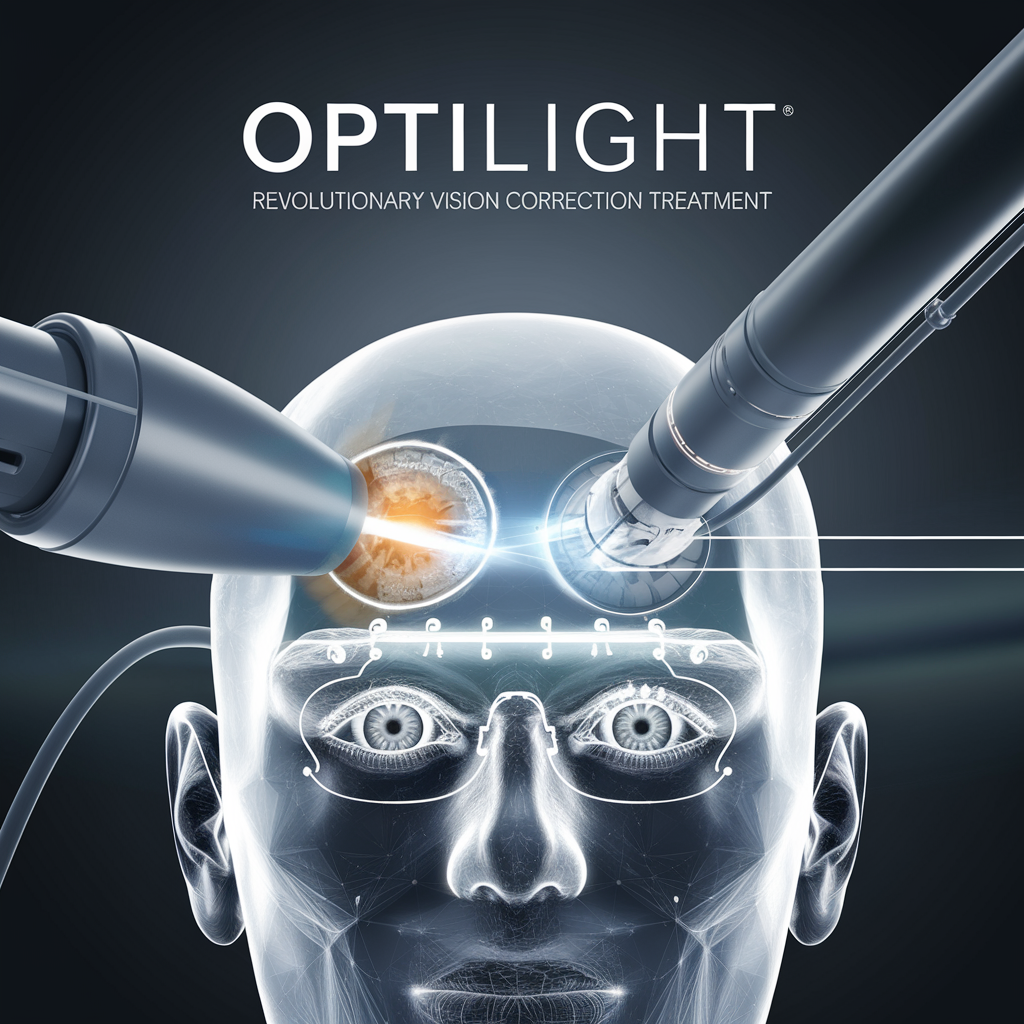OptiLight Covered is a revolutionary new vision correction treatment that uses laser technology to improve eyesight. Many are curious about this minimally invasive technique as an alternative to traditional methods like glasses or LASIK surgical operation. However, one principal question is whether vision coverage plans cover OptiLight.
Critical Points
- OptiLight is a revolutionary laser eye process
- It gives ability advantages over other vision correction techniques
- Understanding coverage coverage is crucial for coping with expenses
This blog post will discover the information on OptiLight, compare if it’s typically included by imaginative and prescient coverage plans, and provide steerage on navigating the coverage panorama for this current treatment.
OptiLight is a groundbreaking vision correction procedure that uses advanced laser technology to improve eyesight. Unlike conventional LASIK surgical operations, which reshape the cornea, OptiLight targets the lens’s interior attention.
The OptiLight procedure uses a precise laser to make microscopic alterations to the lens. These changes regulate how light is focused, correcting refractive mistakes like nearsightedness, farsightedness, and astigmatism.
How OptiLight Works
- The laser creates microscopic patterns on the lens.
- These patterns alter how light is refracted as it passes through the eye.
- Light is focused more precisely onto the retina at the back of the eye.
- The result is sharper, clearer vision without the need for glasses or contacts.
Benefits of OptiLight Compared to Traditional Vision Correction Methods
- Minimally invasive procedure with no cutting or removal of eye tissue.
- Quick treatment time, typically 10-15 minutes per eye.
- Little to no discomfort during or after the procedure.
- Fast recovery, with most patients resuming normal activities the next day.
- Long-lasting results that may eliminate the need for glasses or contacts.
While LASIK reshapes the front part of the eye, OptiLight targets the herbal lens. This critical distinction could make OptiLight appropriate for various imaginative and prescient issues and eye conditions.
Extensive clinical trials have studied the safety and effectiveness of OptiLight vision correction. Research suggests that many sufferers can attain 20/20 or better vision with OptiLight. The chance of incredible headaches may be meager when a skilled doctor performs the technique.
With its revolutionary laser generation and minimally invasive approach, OptiLight is a thrilling new choice in the vision correction discipline. As we explore insurance coverage, it’s crucial to apprehend precisely what this technique involves.
There is no one-size-fits-all answer regarding insurance coverage for imaginative and prescient correction methods like OptiLight. Coverage can range substantially depending on several key factors.
Traditional laser eye surgeries like LASIK have become relatively common, and many imaginative and prescient insurance plans provide minimum partial insurance. However, OptiLight is a newer, more innovative remedy. Insurance businesses frequently categorize pioneering strategies differently.
Insurance Plan Type
| Type of Health Insurance Plan | Coverage Regulations |
| Private Health Insurance Plans | Set their coverage regulations for vision correction |
| Employer-Sponsored Group Plans | May have unique tiers of insurance |
| Government Plans (Medicare/Medicaid) | Have specific guidelines |
Classification of OptiLight
Insurers classify procedures as medically necessary, reconstructive, or optionally available
- Coverage degrees differ based on this clinical necessity determination
- OptiLight’s category could be “experimental” and “imaginative and prescient correction.
Insurance Provider Policies
| Aspect | Details |
| Internal Evaluation Process | Each insurance company has its internal evaluation process. |
| Strategy Examination | Based on clinical evidence and professional guidelines. |
| Innovative Treatment Approval | Selective approval for coverage of innovative treatments like OptiLight. |
| Approval Process | Getting insurance coverage for new procedures can be tricky, but specific steps can help. |
| Coverage Dependence | Coverage can vary based on specific plan details, even with the same insurance provider. |
| Comprehensive Vision Insurance | It is more likely to cover OptiLight, at least partially. |
| Basic Policies | May exclude coverage for OptiLight entirely. |
| Coverage vs. Discounts | It is essential to distinguish between full coverage and discounts or supplements. |
| Reduced Pricing | Some providers may offer reduced out-of-pocket costs through negotiated surgeon fees. |
| Age Factor | Some vision plans cover corrective procedures for children and teenagers up to specific ages. |
| Coverage Basis | OptiLight coverage depends on your specific plan and the insurer’s clinical policies. |
| Maximising Insurance | Steps can be taken to maximize coverage, which will be discussed in the next section. |
The bottom line is that OptiLight’s insurance coverage hinges on your precise plan information and the insurer’s clinical policies.
However, you may take steps to maximize insurance, which we will cover in the subsequent phase.
Read More: Liability Insurance Speech-Language Pathologist
1. Check Your Policy Documents
The first step is carefully reviewing the information in your cutting-edge, imaginative, and prescient medical insurance regulations. Look for any language concerning imaginative and prescient correction procedures, refractive surgery, laser remedies, or scientific necessity requirements.
2. Contact Your Insurance Provider
Refrain from relying entirely on written policy data. Actively contact your coverage enterprise to inquire about coverage for the OptiLight procedure. Getting an explanation directly from a consultant is essential.
3. Understand Pre-Authorization Requirements
Many insurance plans require pre-authorization or pre-certification before procedures like OptiLight are overlayed. This procedure involves your health practitioner filing scientific documentation to get approval beforehand. Be organized to comply with these requirements.
Even if your insurance claim is initially denied, you still have appealing options. Gather supporting evidence such as:
- Expert literature from clinical organizations
- Clinical studies proving the effectiveness of OptiLight
- Documentation from your doctor showing medical necessity
If your appeal is unsuccessful, consider alternative financial solutions like:
- Using tax-advantaged accounts like HSAs or FSAs to cover out-of-pocket costs
- Securing third-party medical financing or payment plans
- Asking your provider about discounts or package deals they may offer
Compile this right into a formal appeals bundle and resubmit it through the proper channels. Persistence can pay off.
It is also sensible to get a clear breakdown of all capacity charges prematurely from your OptiLight healthcare professional. It ensures you can accurately plan for both protected and out-of-pocket expenses.
With some proactive effort, you may enhance your chances of maximizing your vision coverage coverage for this contemporary system. An ounce of preparation prevents a pound of overpayment.
Three main components of the total cost
1. Surgeon’s Professional Fees
It covers the time and understanding of the ophthalmologist appearing for the laser treatment. Surgeon prices can range from $1,500 to $3,000 according to eye, depending on their experience, degree, and geographical location.
2. Facility Fees
The charge is made through the outpatient surgical operation center or health center, where the OptiLight method is performed. Facility fees are often $500 to $1,500, consistent with the eye.
3. Pre-Op and Post-Op Care
Fees for the preliminary session, eye examinations, compliance with-up visits, and any other associated care earlier than and after the laser remedy. It can add $500 to $1,000 overall.
Adding up those three fee additives, the total price of OptiLight vision correction often falls between $4,000 and $7,000 for both eyes.
How a whole lot you may pay out-of-pocket relies upon your specific insurance coverage information:
- If OptiLight is covered, you’ll likely only owe standard copays or coinsurance.
- If partially covered, you’ll be responsible for cost-sharing amounts plus any remaining deductible.
- If not covered, you’ll need to pay the full cost of the procedure out-of-pocket.
To estimate your non-public out-of-pocket responsibility, get the complete procedure prices from your OptiLight provider. Then, determine what element your coverage will cover based primarily on their guidelines. The distinction is what you’ll owe.
Coverage Reductions or Negotiated Fees
Recognize if any imaginative and prescient coverage reductions or negotiated fees are observed to lessen health care professional prices. Taking advantage of those can provide substantial financial savings.
By crunching the numbers earlier, you can ensure you have enough finances set aside via savings, flexible spending debts, financing plans, and so forth. Knowing the ability costs prevents surprises later.
For starters, reaching clear, glasses-unfastened vision with OptiLight gets rid of the ordinary fees associated with prescription eyewear over many years:
- No more buying new glasses frames and lenses ($300-$800 every 2-3 years)
- No more spending on contact lenses and solution ($200-$600 annually)
- No more hassle of losing or replacing glasses and contacts
Cost of OptiLight Covered Insurance
Those costs add up over a lifetime. Paying for OptiLight in advance ought to be extra value-powerful over a long period compared to purchasing new corrective lenses for many years.
OptiLight may qualify for federal tax deductions as a clinical expense, supplying extra value relief. Contributions to tax-advantaged fitness bills are another way to pay the charges with pre-tax bucks.
Beyond just cost, there are quality-of-life benefits from vision freedom as well:
- No more hassle with glasses fogging up, getting wet, or feeling bulky
- No more discomfort from dry eyes or irritation caused by contact lenses
Plus, clearer, sharper vision is achieved through personalized laser correction.
Simple, trouble-unfastened eyesight can beautify daily sports, pastimes, sports activities performance, and more. It’s difficult to place a fee on the one intangible enhancement in confidence and pride.
Of course, the lengthy-term price equation relies upon OptiLight presenting everlasting, solid, imaginative, and prescient correction effects as promised. Clinical records suggest the system is mighty for most patients, executed by a skilled ophthalmologist.
By considering destiny prices and way of life factors, OptiLight laser imaginative and prescient correction might be wise funding for many people despite the higher preliminary rate tag compared to glasses or contacts by myself.
Pros and Cons
Be careful to weigh the pros and cons of your precise imaginative and prescient wishes and financial scenario. But remember those precious long-term OptiLight advantages, too.
As an innovative new vision correction technique, it’s herbal for human beings to have questions and issues about the protection and typical effectiveness of OptiLight. Evaluating the potential dangers is a crucial part of the selection process.
Scientific research and records suggest that OptiLight has a brilliant protection profile with a meager rate of severe headaches or facet effects.
It’s important to note that OptiLight does not make any incisions or remove eye tissue like traditional LASIK surgery. The laser delivers a precise pattern to the lens through the pupil in a minimally invasive fashion, significantly reducing trauma and recovery time.
As for effectiveness, OptiLight demonstrated very promising visual acuity and patient satisfaction results in clinical trials:
In U.S. medical trials involving over 500 patients, the rates of complications were as follows:
- Mild dry eye symptoms: 3.2%
- Temporary vision fluctuations: 2.1%
- Need for an enhancement procedure: 1.5%
- Excessive light sensitivity: 0.8%
- Other minor complications: less than 0.5%
Additionally
- 92% of patients achieved 20/20 vision or better after 9 months
- 99% of patients were satisfied with their unaided vision
- Only 3% required an enhancement procedure to reach their goals
Compared to outcomes information for other vision correction surgical procedures like LASIK and PRK, OptiLight accomplished simply as correctly, if not higher average, in well-decided-on candidates.
Of course, no clinical process is entirely risk-free. However, OptiLight has a completely robust protection document and capability for fantastic, stable visual outcomes, achieved by an experienced OptiLight-licensed doctor following the proper protocols.
Discussing the particular advantages and threat factors with your ophthalmologist is advocated. They can compare your man or woman’s eye fitness and vision to decide if you’ll be an excellent OptiLight candidate.
As we’ve explored extensively, whether OptiLight’s imaginative and prescient correction is covered through insurance has no one-length-suits-all answer. Coverage can vary drastically depending on your specific coverage plan details and your provider’s guidelines.
Few Key Takeaways to Keep in Mind

First, because OptiLight is a newer, more innovative laser eye procedure, many insurance companies may initially classify it as “experimental” or “elective.”
It often translates to limited or no coverage initially. As OptiLight gains widespread adoption and additional clinical data demonstrating its excellent safety profile and effectiveness, insurers may be more inclined to approve coverage.
Actively working directly with your insurance provider, submitting documentation on the medical necessity of OptiLight for your vision correction needs, and persisting through any denial appeals processes can improve your chances of getting costs covered.
Even if OptiLight is not covered upfront, there are ways to soften the financial impact by potentially receiving discounts or maximizing tax-advantaged payments through HSAs or FSAs.
From a big-picture perspective, the long-term benefits of OptiLight may outweigh the initial out-of-pocket costs for many patients compared to traditional glasses or contact lenses. Freedom from corrective lenses and ongoing expenses has provided convenience and savings for decades.
Conclusion
Of course, every individual’s vision, needs, and financial situation is different. It’s critical to carefully weigh the pros and cons with guidance from your ophthalmologist and OptiLight provider. But OptiLight represents an exciting advancement in laser vision correction technology for suitable candidates.
Frequently Asked Questions
How much does OptiLight treatment cost?
OptiLight treatment, often used for managing dry eyes and skin conditions, can vary in price depending on the provider, location, and the number of sessions needed. On average, it costs between $300 to $500 per session. Some clinics may offer package deals if multiple sessions are required.
Are light therapy lamps covered by insurance?
Light therapy lamps, which are commonly used to treat Seasonal Affective Disorder (SAD), are typically not covered by insurance. Most insurance plans consider them as over-the-counter products rather than medical devices, making them an out-of-pocket expense.
Does insurance cover dry eye treatments?
The coverage of dry eye treatments depends on the specific treatment and the insurance plan. Prescription medications for dry eyes, like Restasis or Xiidra, are often covered by insurance. However, other treatments like LipiFlow or IPL (Intense Pulsed Light) therapy might not be covered and are considered elective procedures.
Is phototherapy covered by insurance?
Phototherapy, often used for conditions like psoriasis, eczema, or jaundice, may be covered by insurance if it is deemed medically necessary. Coverage can vary by insurance provider and the specific condition being treated. However, aesthetic or non-medical uses of phototherapy are generally not covered.
Why isn’t LipiFlow covered by insurance?
LipiFlow is not typically covered by insurance because it is considered an elective or cosmetic treatment rather than a medically necessary procedure. Most insurance companies classify it as an advanced dry eye treatment rather than a basic medical treatment, so it falls outside of standard coverage.
Is IPL for dry eye covered by insurance?
IPL (Intense Pulsed Light) for dry eye is generally not covered by insurance. Similar to LipiFlow, it is considered an elective or experimental treatment by many insurers, and they may not provide coverage unless more traditional treatments have been proven ineffective.
Is IPL covered by Medicare?
Medicare usually does not cover IPL treatments, as they are often classified as elective or cosmetic procedures. However, if the IPL is deemed medically necessary, such as for certain skin conditions, you may need to check with Medicare directly to see if there are any exceptions.
Does Medicare cover dry eye treatment?
Medicare typically covers some dry eye treatments, such as prescription medications (e.g., Restasis, Xiidra) or medical visits related to dry eye. However, advanced treatments like LipiFlow, IPL, and other non-prescription therapies are usually not covered.
Is LipiFlow covered by insurance?
No, LipiFlow is typically not covered by insurance. It is considered an elective or non-essential treatment for dry eye syndrome, which excludes it from standard insurance coverage.
Is IPL for rosacea covered by insurance?
IPL for rosacea is often not covered by insurance because it is considered a cosmetic procedure. Most insurers classify IPL as elective, even though it can help manage skin conditions like rosacea. Coverage may vary depending on the insurer, so it’s important to verify with your provider.

Justin Taylor is the creative force behind Insuranted.com, a premier destination for insightful and trustworthy insurance information. With a dedication to demystifying insurance complexities, Justin strives to equip readers with the knowledge they need to make smart, informed decisions.










